Uncertain Accelerated Sea-Level Rise, Potential Consequences, and Adaptive Strategies in The Netherlands
Abstract
:1. Introduction
2. The Netherlands and the Delta Programme
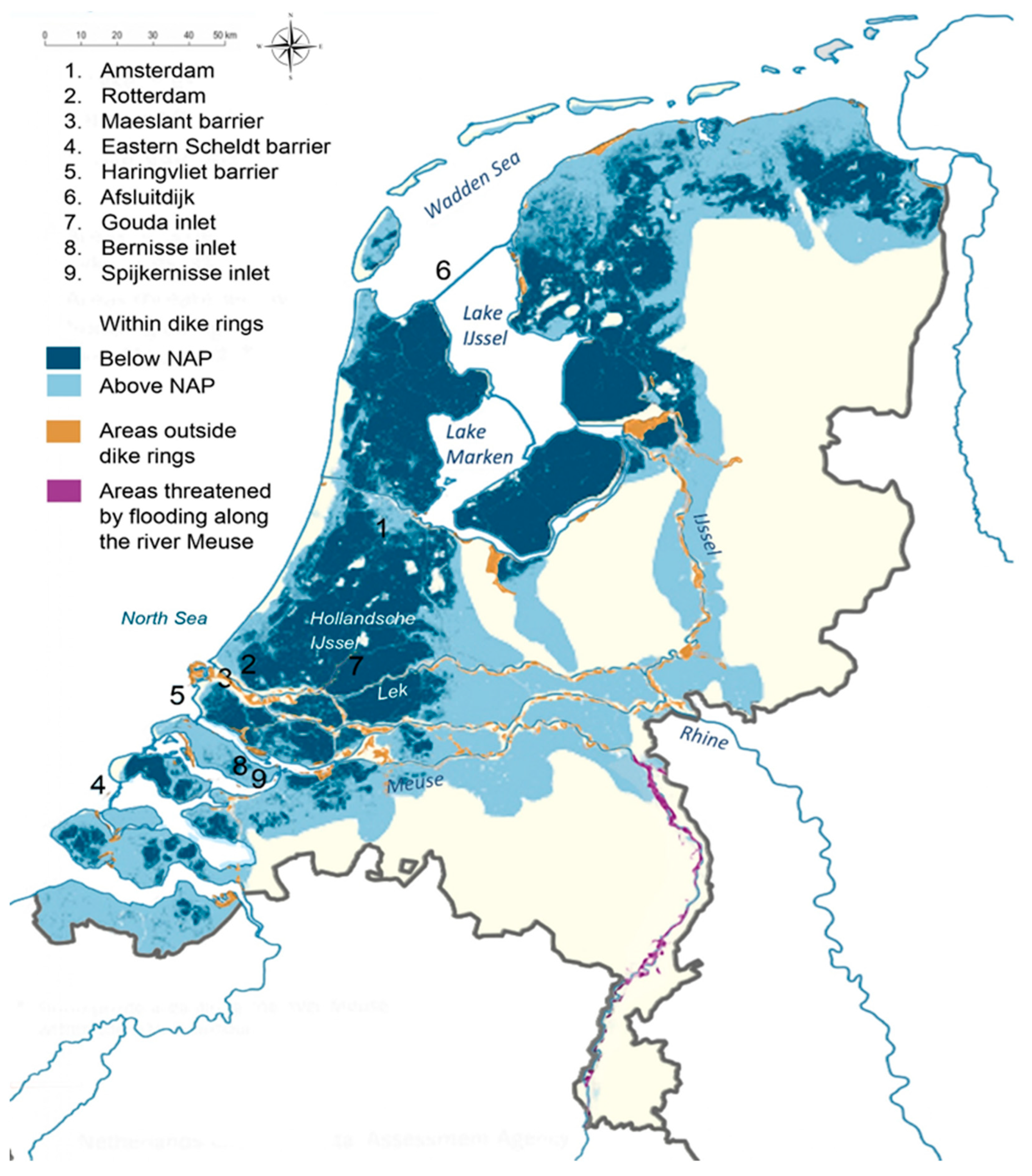
3. Materials and Methods
4. Results
4.1. The Potential Impact of Sea-Level Rise on the Dutch Delta
4.2. Strategies to Cope with Sea-Level Rise
- ▪
- Retreat, which involves reducing the exposure to coastal hazards by moving people, assets, and activities landward to higher ground. This choice can be motivated by excessive economic or environmental impacts of protection or long-term adaptation needs;
- ▪
- Accommodate, which implies that people continue to use the land at risk but do not attempt to prevent the land from being flooded. This option includes creating emergency flood shelters, elevating buildings on piles or mounds, converting agriculture to fish farming, or growing flood or salt tolerant crops;
- ▪
- Protect, which involves hard structures such as seawalls and dikes, as well as nature-based solutions such as dunes and vegetation, to protect the land from the sea so that existing land uses can continue. Protection can be provided by strengthening the existing coastline or by advancing a higher new coastline.
- (a)
- Close them off from the sea completely by dams, navigation locks, and sluices. This ‘protect-closed’ strategy protects the inland area against SLR and the related salinization. However, handling river discharge requires enormous pumping stations, with a capacity of several thousand m3/s, in combination with large areas for temporary flood storage.
- (b)
- Maintain the open connection with the sea. In this ‘protect-open’ strategy, rising sea level extends its influence upstream along the rivers, flooding unembanked (harbor) areas and requiring extensive dike improvement programmes to maintain flood protection standards. In addition, a large inland area may be affected by salinization of surface waters.
- Until 2050, SLR projections for different emission scenarios vary only little. Therefore, a continuation of the present protect strategy seems logical as a first step. A complicated societal debate is avoided, choices can be postponed until more knowledge about SLR becomes available, and present land use can be continued by increasing the present technical measures in flood protection and water management, presumably up to a sea-level rise of 2 m and a related rate of SLR. The increasing volumes involved in beach nourishments (up to 60 million m3/year) can be dredged on the Dutch continental shelf. This strategy largely depends on scaling up present sand extraction and beach nourishments operations of generally 1–5 million m3 per project. An interesting pilot is the so-called ‘Sand motor’, a 1.28 km2 beach nourishment of 21.5 million m3, costing about EUR 70 million. After 10 years of monitoring, it was concluded that the ‘Sand motor’ acted as a ‘feeder beach’ from which the sand is transported to adjacent dunes and beaches by natural processes such as wind, tidal currents, and waves [30]. It also illustrated the ‘benefits of scale’ effect, since such larger volumes enable the use of more efficient large vessels and nourishment techniques, and reduces the costs of material mobilization and demobilization costs for ground works. As a consequence, the usual beach nourishment costs were almost halved.
- In addition to these kind of pilots, low-regret measures can be taken, such as spatial reservations for sand extraction in the North Sea, to avoid conflicts with other marine users, including wind farm developers. Nevertheless, a large loss of intertidal areas in the Wadden Sea cannot be prevented if SLR rates consistently exceed 6 mm/year (western Wadden Sea) or 10 mm/year (Eastern Wadden sea). Nor can the salt intrusion be fully avoided. In this way, the protection pathway is continued, with the risk of large transfer cost for future generations, if a shift to other strategies is needed.
- With rising sea levels, the first dilemma that may emerge is whether to permanently close the estuaries or to keep them open to facilitate free river discharge. To keep both options open in the coming decades, it is necessary to avoid new developments in unembanked areas (or at least make them flood-proof), and reserve space for future dike improvements. A first inventory shows that future dike raising requires 12–17 m additional horizontal space per meter raised. This requires valuable space, especially in urban areas such as Rotterdam, which can only be used for temporary activities. Furthermore, in the closed option, drainage of river discharge requires large pumping capacity, up to several thousand m3/s or even more. This pumping requirements can be reduced when flood waters can be temporarily stored. This storage capacity can be found in present water systems, or in creating new systems in the coastal zone, attached to the river mouths. Model simulations can help find the optimum combination of dike raising, storage volumes, and pumping capacity.
- Regarding agriculture and horticulture, a gradual transition to salt (and drought)-tolerant crops is low-regret, since salinization of the coastal area is expected in both the retreat and protection strategies.
- With continued SLR and increasing technical efforts, a fundamental choice between ‘advance’ or ‘retreat’ becomes inevitable. The ‘advance’ strategy can be seen as a next step in the present protective strategy, heavily relying on technical measures such as flood defenses and pumps. Therefore, some experts advocate to start with this strategy already, and avoid short-term expenses on maintenance and on upgrading the present flood and water management infrastructure. The retreat strategy marks a significant ‘change of mind’, which may be reached after a long societal debate, or become reality when natural disaster creates a ‘fait accompli’.
4.3. The First Step
- research aimed to reduce the uncertainty regarding SLR. This requires international cooperation on polar research, but also on monitoring SLR in coastal seas;
- develop a method to signal a potential acceleration of SLR timely and with sufficient confidence. This involves statistical research on SLR data and projections;
- establish the potential effects on the flood risk and water management of the Dutch delta and related infrastructure and establish the lifetime of the present policies. Detailed model computations for different SLR scenarios must be performed to predict future coastal erosion, necessary beach nourishment volumes, hydraulic loads and required flood defense strengthening, storage and pumping capacities, and increase of fresh water supply. Special attention is paid to the discharge of river water with the rising sea-level [35], which is a major challenge for many deltas worldwide;
- explore long-term options which might become necessary when present policies become short. In this situation, the present territory and land use of the Netherlands might be affected by regular or permanent flooding and salt intrusion. In cooperation with other authorities and NGOs, it must be explored whether present investment agendas on, e.g., housing, infrastructure, and sustainable energy may occupy land that might be necessary for future strategies to deal with SLR, and how these agendas can be aligned to create synergy with these future strategies;
- prepare the implementation of the necessary policies and measures by:
- o
- collecting expertise and knowledge on large-scale long-term societal transitions;
- o
- starting pilots to gain experience with the possibilities to scale up present techniques and methods (e.g., building with nature);
- o
- propose spatial reservations for future sand extraction, flood protection, water discharge, storage, and supply; and
- o
- introducing the adaptive approach in the design of projects that are planned for the coming years in housing, infrastructure, and replacement of present (aging) infrastructure.
5. Discussion and Conclusions
- research into the behavior of Antarctic ice, combined with the development of a method to signal SLR acceleration in a timely way with sufficient confidence;
- research into the consequences of accelerated SLR on present water management infrastructure such as flood defenses, storm surge barriers, locks and pumping stations, and fresh water intake locations. How will SLR affect their lifetime, maintenance, replacement, or reconstruction? Consequently, what will be the effect on the land use that this affected infrastructure serves? Which strategic choices in water management and land use strategies become inevitable? E.g., is the present type of fresh-water-based agriculture in the coastal zone sustainable with increasing salinization due to SLR? Or do we continue with new urban development in low-lying coastal areas which require increasing efforts to maintain dry?;
- the exploration of long-term strategies (e.g., ‘protect’, ‘advance’, ‘accommodate’, and ‘retreat’) that might become necessary when present policies start to fail. Vice versa, identify necessary short-term measures to keep these future strategies open and avoid regret investments. An important no-regret measure is the spatial reservation for future sand extraction (for beach nourishments) and for future expansion of flood defenses, water discharge, and water storage.
- flexible measures, which are important to bridge the coming decades of uncertainty in SLR. Nature-based solutions, such as beach nourishments or stimulating natural sedimentation on flood defense forelands, are relatively cheap and more flexible to adapt to changing conditions than concrete structures. In addition, they have beneficial side effects on, e.g., nature restoration and recreation. Pilots may be helpful to improve the effectiveness of these measures and establish their ‘scaling up’ potential, as illustrated by the Sand motor mega beach nourishment [30].
- adaptive design. When decisions have to be made regarding the (re)construction of long-lifetime robust infrastructure, an adaptive design should be promoted, to make future expansion possible without excessive costs.
Author Contributions
Funding
Institutional Review Board Statement
Informed Consent Statement
Conflicts of Interest
References
- Global Commission on Climate Adaptation. Adapt Now: A Global Call for Leadership on Climate Resilience; Global Center on Adaptation: Rotterdam, The Netherlands; World Resources Institute: Washington, DC, USA, 2019. [Google Scholar]
- IPCC. Summary for Policymakers. In Climate Change 2022: Impacts, Adaptation and Vulnerability. Contribution of Working Group II to the Sixth Assessment Report of the Intergovernmental Panel on Climate Change; Cambridge University Press: Cambridge, UK, 2022; Available online: https://www.ipcc.ch/report/ar6/wg2/ (accessed on 9 May 2022).
- IPCC. Summary for Policymakers. In Climate Change 2021: The Physical Science Basis. Contribution of Working Group 1 to the Sixth Assessment Report of the Intergovernmental Panel on Climate Change; Cambridge University Press: Cambridge, UK, 2021; Available online: https://www.ipcc.ch/report/ar6/wg1/#SPM (accessed on 20 March 2022).
- Bloemen, P.J.T.M.; Hammer, F.; Van der Vlist, M.J.; Grinwis, P.; Van Alphen, J. DMDU into practice: Adaptive Delta Management in the Netherlands. In Decision Making under Deep Uncertainty: From Theory to Practice; Marchau, V.A.W.J., Walker, W.E., Bloemen, P.J.T.M., Popper, S.W., Eds.; Springer International Publishing: Cham, Switzerland, 2019; pp. 321–351. [Google Scholar] [CrossRef] [Green Version]
- IPCC. Strategies for Adaptation to sea Level Rise; Report of the Coastal Zone Management Subgroup, IPCC Response Strategies Working Group; Ministry of Transport and Public Works, Rijkswaterstaat, Tidal Water Division: The Hague, The Netherlands, 1990; Available online: https://puc.overheid.nl/rijkswaterstaat/doc/PUC_26288_31/ (accessed on 9 May 2022).
- OECD. Water Governance in the Netherlands, Fit for the Future? OECD Studies on Water; OECD Publishing: Paris, France, 2014. [Google Scholar] [CrossRef]
- Deltacommissaris. The 2022 Delta Programme, Every New Development Climate-Proof; Ministry of Infrastructure and Water Management: The Hague, The Netherlands, 2021; Available online: https://english.deltaprogramma.nl/documents/publications/2021/09/21/dp-2022-in-english---print-version (accessed on 20 March 2022).
- Deltacommissaris. The 2011 Delta Programme, Working on the Delta; Ministry of Transport; Public Works and Water Management: The Hague, The Netherlands, 2010. [Google Scholar]
- Haasnoot, M.; van’t Klooster, S.; Van Alphen, J. Designing a monitoring system to detect signals to adapt to uncertain climate change. Glob. Environ. Chang. 2018, 52, 273–285. [Google Scholar] [CrossRef]
- Haasnoot, M.; Kwadijk, J.; Van Alphen, J.; LeBars, D.; Van den Hurk, B.; Diermanse, F.; Van der Spek, A.; Oude Essink, G.; Delsman, J.; Mens, M. Adaptation to uncertain sea-level rise: How uncertainty in Antarctic mass-loss impacts coastal adaptation strategy of the Netherlands. Environ. Res. Lett. 2020, 15, 034007. [Google Scholar] [CrossRef]
- Deltacommissaris. The 2015 Delta Programme, Working on the Delta. The Decisions to Keep the Netherlands Safe and Liveable; Ministry of Infrastructure and the Environment: The Hague, The Netherlands, 2014. [Google Scholar]
- Royal Dutch Meteorological Institute KNMI. KNMI’14 Climate Scenarios for the Netherlands; A Guide for Professionals in Climate Adaptation; KNMI: De Bilt, The Netherlands, 2015; 34p, Available online: https://www.knmiprojects.nl/projects/climate-scenarios/documents/publications/2015/01/01/brochure-knmi14-climate-scenarios (accessed on 24 December 2021).
- IPCC. Climate Change 2014: Synthesis Report. Contribution of Working Groups I, II and III to the Fifth Assessment Report of the Intergovernmental Panel on Climate Change; IPCC: Geneva, Switzerland, 2014; 151p. [Google Scholar]
- Deltacommissaris. The 2018 Delta Programme, Continuing the Work on a Sustainable and Safe Delta; Ministry of Infrastructure and the Environment: The Hague, The Netherlands, 2017. [Google Scholar]
- Hekman, A.; Booister, N. Ruimte voor de Toekomst, Flexibel Invullen van Investeringsopgaven om Effecten van Zeespiegelstijging in de Toekomst te Kunnen Opvangen; White Paper; SWECO Nederland: De Bilt, The Netherlands, 2021. (In Dutch) [Google Scholar]
- Broderick, C.; Murphy, C.; Wilby, R.L.; Matthews, T.; Prudhomme, C.; Adamson, M. Using a scenario-neutral framework to avoid potential maladaptation to future flood risk. Water Resour. Res. 2019, 55, 1079–1104. [Google Scholar] [CrossRef] [PubMed]
- Kwadijk, J.; Haasnoot, M.; Mulder, J.P.M.; Hoogvliet, M.M.C.; Jeuken, A.B.M.; Van der Krogt, R.A.A.; Van Oostrom, N.G.C.; Schelfhout, H.A.; Van Velzen, E.H.; Van Waveren, H.; et al. Using adaptation tipping points for climate change and sea level rise: A case study in the Netherlands. Wiley Interdiscip. Rev. Clim. Chang. 2010, 1, 729–740. [Google Scholar] [CrossRef]
- Slangen, A.; Haasnoot, M.; Winter, G. Rethinking Sea-Level Projections Using Families and Timing Differences. Earth Futures 2022, 10, e2021EF002576. [Google Scholar] [CrossRef]
- Zijl, F.; Sumihar, J.; Verlaan, M. Application of data assimilation for improved operational water level forecasting on the northwest European shelf and North Sea. Ocean Dyn. 2015, 65, 1699–1716. [Google Scholar] [CrossRef] [Green Version]
- Oude Essink, G.H.P.; Van Baaren, E.S.; De Louw, P.G.B. Effects of climate change on coastal groundwater systems: A modeling study in the Netherlands. Water Resour. Res. 2010, 46. [Google Scholar] [CrossRef]
- De Lange, W.J.; Prinsen, G.F.; Hoogewoud, J.C.; Veldhuizen, A.A.; Verkaik, J.; Oude Essink, G.H.P.; Van Walsum, P.E.V.; Delsman, J.R.; Hunink, J.C.; Massop, H.T.L.; et al. An operational, multi-scale, multi-model system for consensus-based, integrated water management and policy analysis: The Netherlands Hydrological Instrument. Environm. Model. Softw. 2014, 59, 98–108. [Google Scholar] [CrossRef] [Green Version]
- Deltares. Kustwiki. Available online: https://publicwiki.deltares.nl/display/KWI/Projects (accessed on 28 March 2022). (In Dutch).
- Van der Spek, A.J.F. The development of the tidal basins in the Dutch Wadden Sea until 2100: The impact of accelerated sea-level rise and subsidence on their sediment budget—A synthesis. Netherlands J. Geosci. 2018, 97, 71–78. [Google Scholar] [CrossRef] [Green Version]
- Haasnoot, M.; Diermanse, F.; Kwadijk, J.; de Winter, R.; Winter, G. Strategieën voor adaptatie aan hoge en versnelde zeespiegelstijging, een verkenning; Deltares rapport 11203724-004; Deltares: Delft, The Netherlands, 2019. (In Dutch) [Google Scholar]
- Van Alphen, S. Room for the River: Innovation, or Tradition? The Case of the Noordwaard. In Adaptive Strategies for Water Heritage; Hein, C., Ed.; Springer: Cham, Switzerland, 2020; pp. 309–323. [Google Scholar] [CrossRef] [Green Version]
- Marijnissen, R.J.C.; Kok, M.; Kroeze, C.; Van Loon-Steensma, J.M. Flood risk reduction by parallel flood defences—Case-study of a coastal multifunctional flood protection zone. Coast. Eng. 2021, 167, 103903. [Google Scholar] [CrossRef]
- Haasnoot, M.; Kwakkel, J.H.; Walker, W.E.; Ter Maat, J. Dynamic Adaptive Policy Pathways: A New Method for Crafting Robust Decisions for a Deeply Uncertain World. Glob. Environ. Chang. 2013, 23, 485–498. [Google Scholar] [CrossRef] [Green Version]
- Van Alphen, J. The Delta Programme and updated flood risk management policies in the Netherlands. J. Flood Risk Manag. 2016, 9, 310–319. [Google Scholar] [CrossRef]
- De Neuville, R.; Smet, K.; Cardin, M.A.; Ranjbar-Bourani, M. Dynamic adaptive planning (DAP): The case of intelligent speed adaptation. In Decision Making under Deep Uncertainty: From Theory to Practice; Marchau, V.A.W.J., Walker, W.E., Bloemen, P.J.T.M., Popper, S.W., Eds.; Springer International Publishing: Cham, Switzerland, 2019; pp. 223–252. [Google Scholar] [CrossRef] [Green Version]
- Available online: Sand Motor—Building with Nature Solution to Improve Coastal Protection along Delfland Coast (The Netherlands). Available online: https://climate-adapt.eea.europa.eu/metadata/case-studies/sand-motor-2013-building-with-nature-solution-to-improve-coastal-protection-along-delfland-coast-the-netherlands (accessed on 20 March 2022).
- Seven Years after Tsunami, Japanese Live Uneasily with Seawalls. Available online: https://www.reuters.com/article/us-japan-disaster-seawalls/seven-years-after-tsunami-japanese-live-uneasily-with-seawalls-idUSKCN1GL0DK (accessed on 20 March 2022).
- Saemangeum Seawall. Available online: https://en.wikipedia.org/wiki/Saemangeum_Seawall (accessed on 20 March 2022).
- Out of the Deep: 7 Massive Land Reclamation Projects. Available online: https://ww3.rics.org/uk/en/modus/natural-environment/land/out-of-the-deep--7-massive-land-reclamation-projects--.html (accessed on 20 March 2022).
- Sea Level Rise Knowledge Programme. Available online: https://english.deltaprogramma.nl/delta-programme/knowledge-development/sea-level-rise-knowledge-programme (accessed on 30 March 2022).
- De Bruijn, K.; Diermanse, F.L.M.; Weiler, O.M.; De Jong, J.S.; Haasnoot, M. Protecting the Rhine-Meuse delta against sea level rise: What to do with the river’s discharge? J. Flood Risk Manag. 2022, e12782. [Google Scholar] [CrossRef]
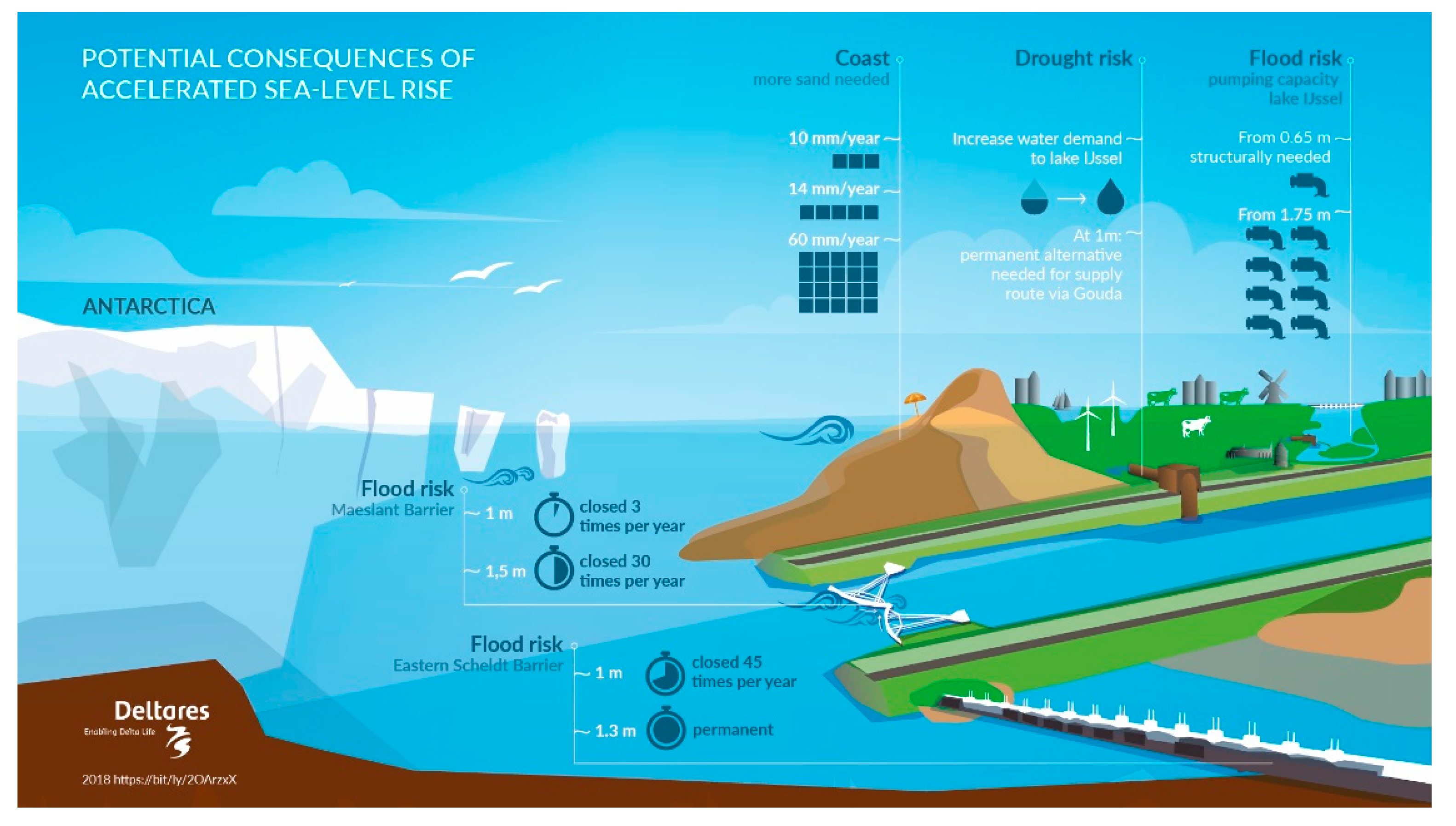

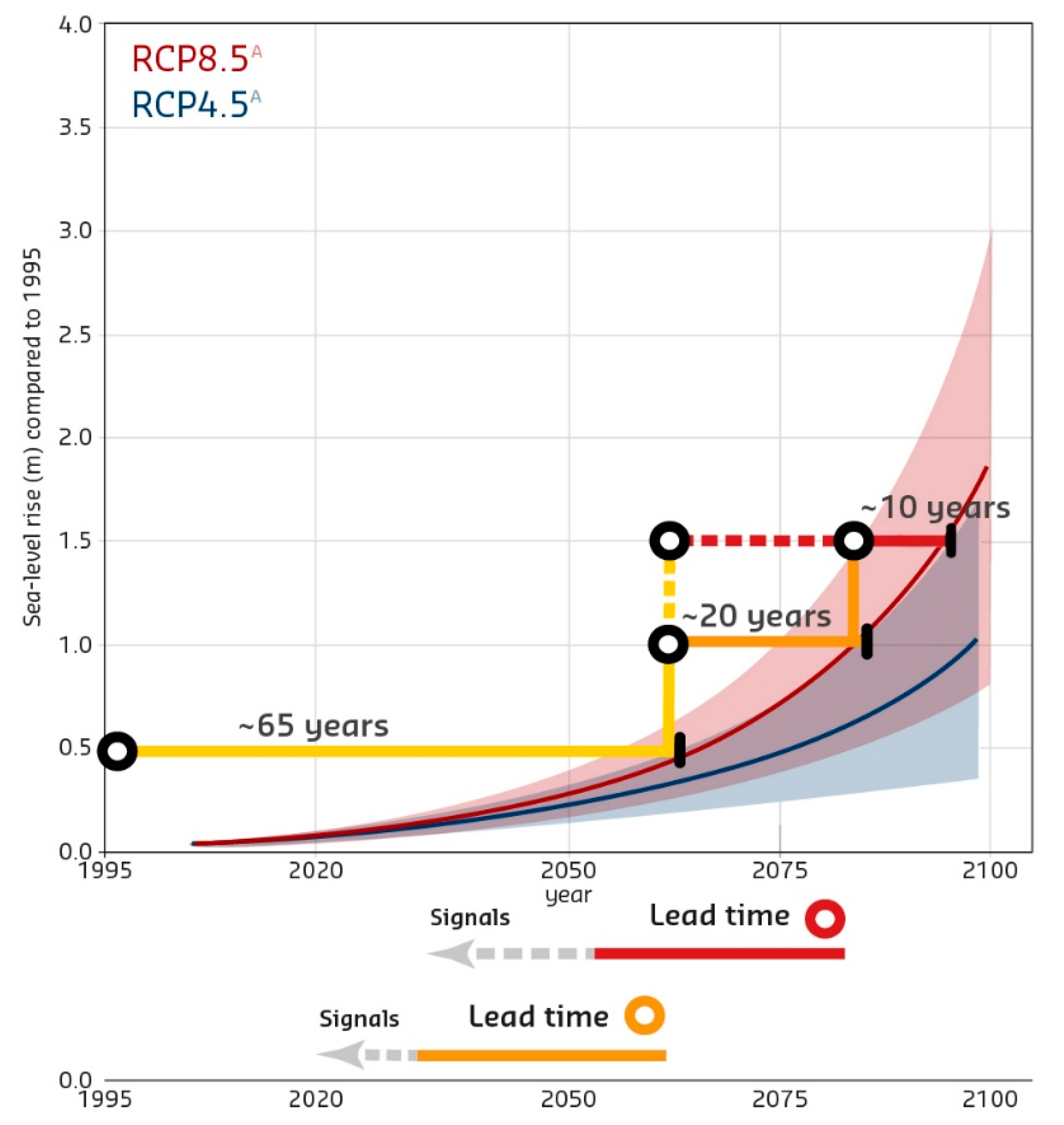
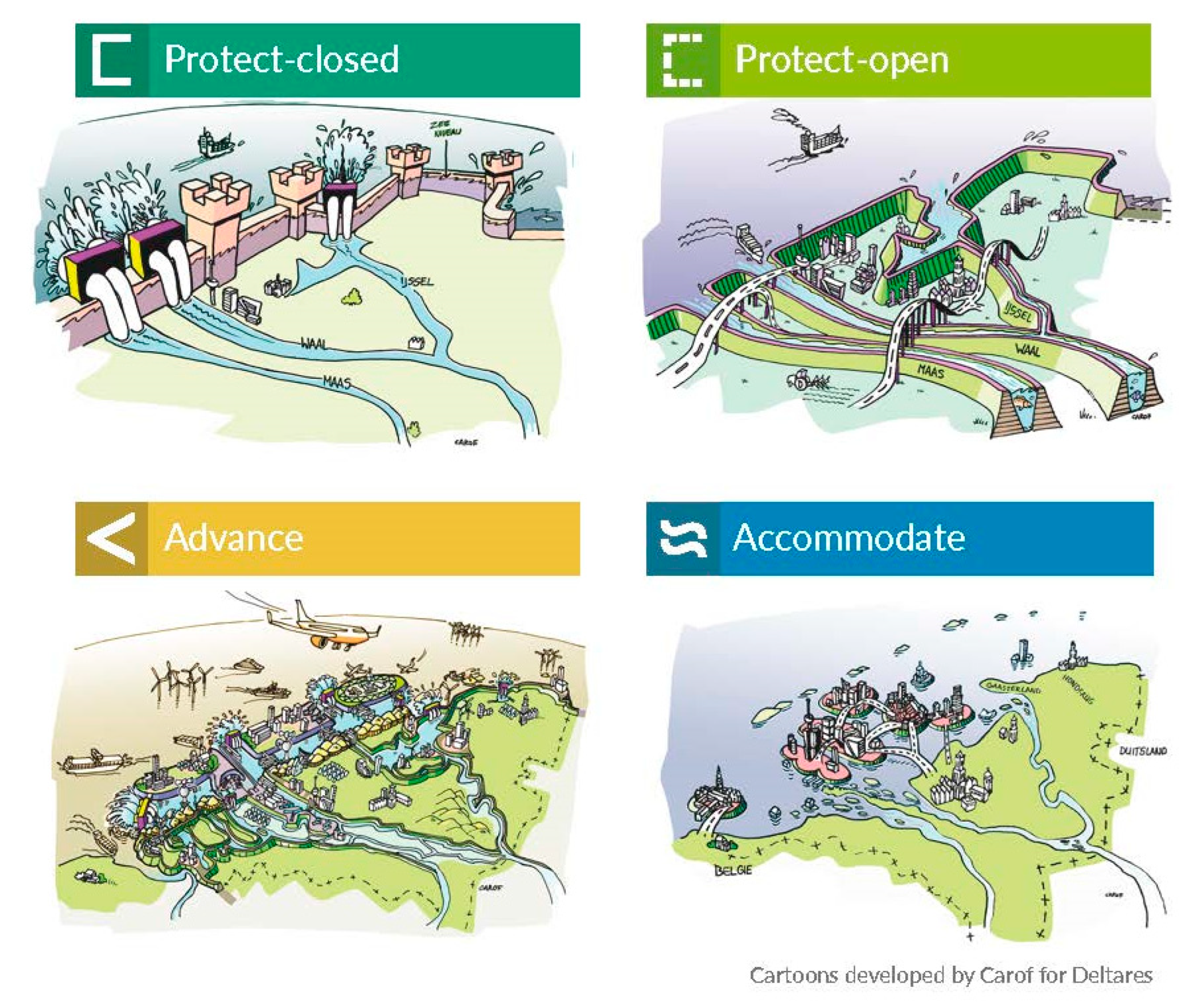
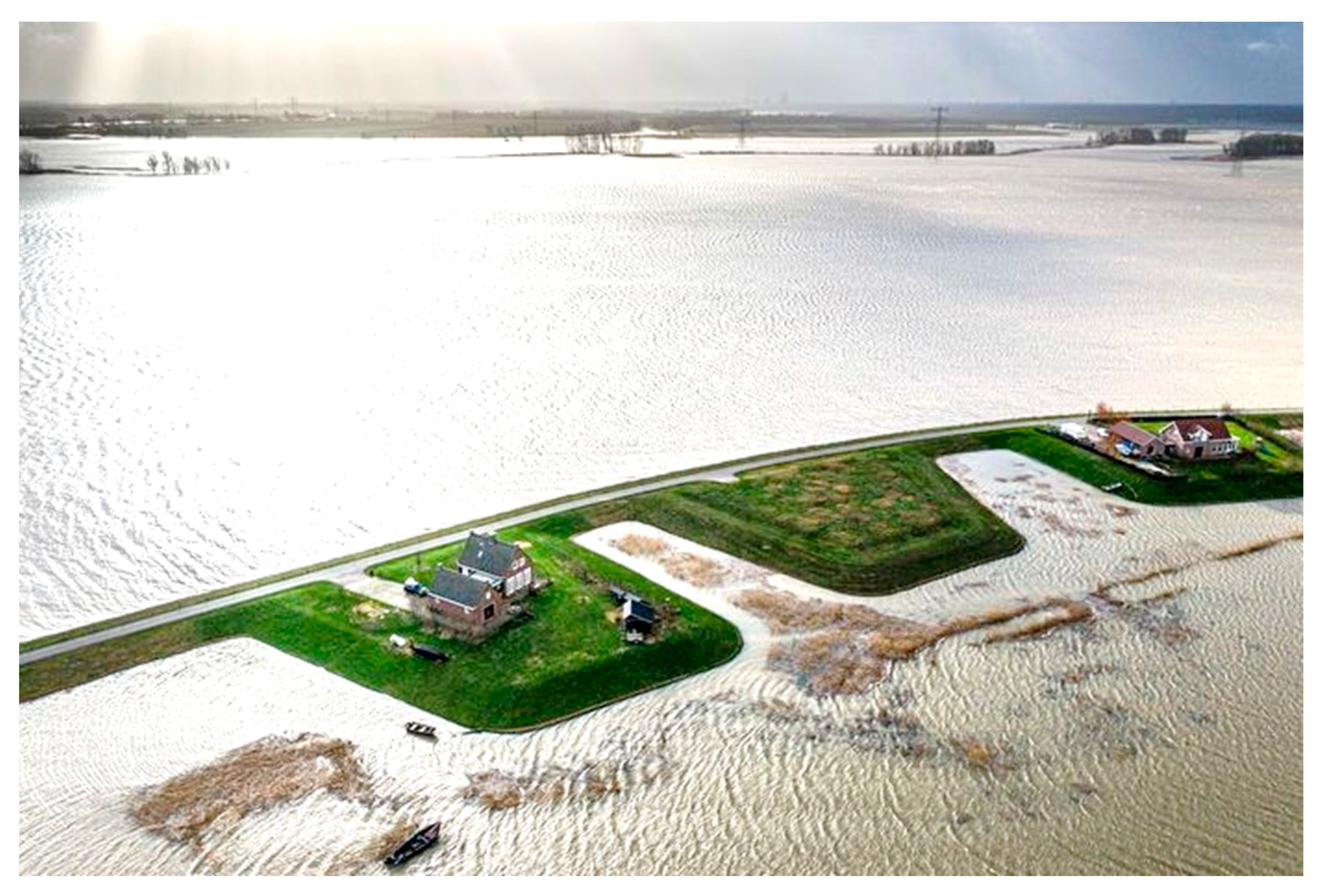

Publisher’s Note: MDPI stays neutral with regard to jurisdictional claims in published maps and institutional affiliations. |
© 2022 by the authors. Licensee MDPI, Basel, Switzerland. This article is an open access article distributed under the terms and conditions of the Creative Commons Attribution (CC BY) license (https://creativecommons.org/licenses/by/4.0/).
Share and Cite
van Alphen, J.; Haasnoot, M.; Diermanse, F. Uncertain Accelerated Sea-Level Rise, Potential Consequences, and Adaptive Strategies in The Netherlands. Water 2022, 14, 1527. https://doi.org/10.3390/w14101527
van Alphen J, Haasnoot M, Diermanse F. Uncertain Accelerated Sea-Level Rise, Potential Consequences, and Adaptive Strategies in The Netherlands. Water. 2022; 14(10):1527. https://doi.org/10.3390/w14101527
Chicago/Turabian Stylevan Alphen, Jos, Marjolijn Haasnoot, and Ferdinand Diermanse. 2022. "Uncertain Accelerated Sea-Level Rise, Potential Consequences, and Adaptive Strategies in The Netherlands" Water 14, no. 10: 1527. https://doi.org/10.3390/w14101527
APA Stylevan Alphen, J., Haasnoot, M., & Diermanse, F. (2022). Uncertain Accelerated Sea-Level Rise, Potential Consequences, and Adaptive Strategies in The Netherlands. Water, 14(10), 1527. https://doi.org/10.3390/w14101527




